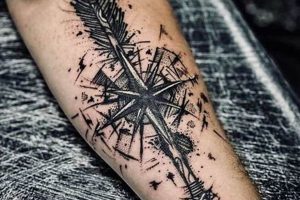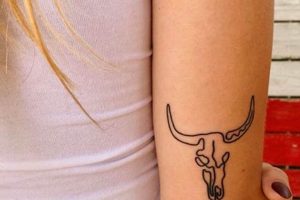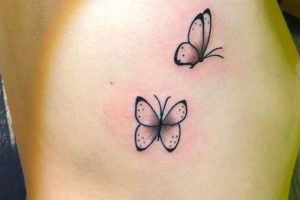Minimalist tattoos characterized by clean lines and often lacking shading or color have surged in popularity. These designs range from delicate florals and geometric patterns to single-line depictions of animals or objects. A small, unfilled outline of a mountain range or a fine-lined rendering of a pet’s silhouette exemplifies this aesthetic.
The elegance of this style lies in its simplicity. These tattoos often age well due to the clarity of the lines, and their understated nature makes them versatile and easily adaptable to various placements on the body. Historically, fine line tattoos can be linked to ancient tattooing traditions that utilized basic tools and techniques, emphasizing clean execution and symbolic imagery. The modern resurgence reflects an appreciation for minimalism and enduring design.
Further exploration will delve into specific design categories, artist selection considerations, and aftercare practices for these minimalist body art pieces.
Tips for Minimalist Tattoo Designs
Careful consideration ensures a timeless and aesthetically pleasing result when opting for a minimalist tattoo.
Tip 1: Research Artists Specializing in Fine Linework: Not all tattoo artists excel in this intricate style. Review portfolios for artists demonstrating consistent precision and a light touch. Look for examples of healed work to gauge long-term results.
Tip 2: Prioritize Simplicity: Less is often more. Overly complex designs can lose clarity when reduced to fine lines. Opt for clean, impactful imagery.
Tip 3: Consider Placement Carefully: Placement impacts visibility and longevity. Areas with frequent movement or sun exposure may experience faster fading. Discuss ideal placement with a chosen artist.
Tip 4: Size Matters: Extremely small, intricate designs can blur over time. Ensure the design maintains clarity at its intended size. Consult with an artist to determine the minimum viable size for intricate details.
Tip 5: Embrace Negative Space: Negative space is a powerful tool in minimalist design. It can create visual interest and enhance the overall aesthetic by allowing skin to show through as part of the design.
Tip 6: Think Long-Term: Minimalist tattoos, while generally aging well, still require touch-ups eventually. Consider the long-term commitment and factor in potential maintenance.
Choosing a minimalist tattoo requires thoughtful planning and collaboration with a skilled artist. These considerations ensure a piece that remains visually appealing for years to come.
Following these guidelines contributes significantly to a successful and satisfying tattoo experience, resulting in body art that reflects personal style with understated elegance.
1. Clean Lines
Clean lines are the cornerstone of simple line work tattoos, defining the aesthetic and impacting longevity. The precision and clarity of these lines distinguish the style and contribute significantly to the overall visual impact. This section explores the multifaceted aspects of clean lines in minimalist tattooing.
- Precision and Artistry
Clean lines demand a high level of skill from the artist. A steady hand, precise needle control, and an understanding of line weight variation are crucial. A skilled artist can create flowing, unbroken lines that enhance the design’s elegance and ensure it ages gracefully. Examples include crisp geometric patterns or the delicate curves of a botanical illustration, showcasing the artist’s mastery.
- Impact of Ink and Needles
Ink quality and needle selection directly influence line clarity. High-quality tattoo ink formulated for fine lines ensures crispness and prevents blurring over time. Appropriate needle sizes and configurations are essential for achieving the desired line weight and preventing unnecessary trauma to the skin. This contributes to sharper lines and quicker healing.
- Longevity and Aging
Clean lines are essential for a tattoo that ages well. Blurred or uneven lines are more susceptible to fading and distortion over time. Precisely executed lines maintain their definition, ensuring the design remains visually appealing for years to come. Comparing a healed, clean-lined tattoo with a faded, poorly executed one illustrates this difference starkly.
- Visual Impact and Aesthetics
Clean lines contribute significantly to the overall aesthetic of the tattoo. They create a sense of elegance, simplicity, and precision. Whether the design is a minimalist geometric shape or a more complex single-line illustration, clean lines enhance the visual impact, allowing the design to stand out with clarity and sophistication.
The importance of clean lines in simple line work tattoos cannot be overstated. They are the defining characteristic of the style, impacting not only the initial aesthetic appeal but also the longevity and clarity of the design over time. A skilled artist’s precise execution, combined with high-quality materials, results in a tattoo that embodies minimalist elegance and enduring beauty.
2. Minimal Shading
Minimal shading plays a crucial role in simple line work tattoos, enhancing depth and dimension without overwhelming the inherent minimalist aesthetic. Its strategic use can subtly amplify the design’s impact while preserving the clean, uncluttered look characteristic of this style. This section explores the nuanced relationship between minimal shading and simple line work tattoos.
- Subtle Depth and Dimension
Minimal shading introduces subtle depth and dimension to otherwise flat, two-dimensional designs. Sparsely applied shading can create the illusion of volume or curvature, adding visual interest without detracting from the overall simplicity. For example, a few strategically placed lines can suggest the curve of a petal or the contour of a face.
- Emphasis and Focal Points
Shading can draw the eye to specific areas of the tattoo, creating focal points and emphasizing key elements. A touch of shading can highlight the center of a flower or the curve of a leaf, enhancing the overall composition and guiding the viewer’s gaze. This subtle emphasis adds depth of meaning without overwhelming the design’s minimalist nature.
- Texture and Visual Interest
Even minimal shading can introduce texture and visual interest. Stippling, a technique involving small dots of ink, can create a textured effect, suggesting fur, scales, or other tactile surfaces. Similarly, subtle gradients can create a sense of light and shadow, adding depth and complexity without sacrificing the clean lines of the design.
- Balance and Composition
Minimal shading contributes to the overall balance and composition of the tattoo. By strategically applying shading, an artist can create visual harmony and balance within the design. This can involve darkening certain areas to create a sense of weight or using shading to connect disparate elements, resulting in a cohesive and aesthetically pleasing composition.
In the context of simple line work tattoos, minimal shading serves as a powerful tool for enhancing visual impact while preserving the core principles of minimalism. Its judicious use contributes to the depth, dimension, and overall aesthetic of the design, demonstrating the sophisticated interplay between simplicity and subtle detail in this distinctive tattoo style.
3. Symbolic Imagery
Symbolic imagery forms a core component of simple line work tattoos, imbuing minimalist designs with deeper meaning and personal significance. The inherent simplicity of the style lends itself to symbolic representation, allowing for powerful visual storytelling through clean lines and uncluttered forms. This section explores the integral role of symbolic imagery in minimalist tattoo design.
- Cultural and Historical Significance
Many symbols carry rich cultural and historical weight, adding layers of meaning to a tattoo. From ancient runes and celestial bodies to botanical motifs and geometric patterns, these symbols connect individuals to broader cultural narratives and historical traditions. A simple wave, for instance, can symbolize the power of nature, while a lotus flower represents purity and rebirth in various Eastern cultures.
- Personal Narratives and Experiences
Symbolic imagery allows individuals to express personal narratives and experiences through minimalist designs. A single line depicting a mountain range can symbolize a love of nature or a significant journey, while a minimalist outline of a pet can represent companionship and loyalty. These personalized symbols transform tattoos into intimate expressions of individual stories and values.
- Abstract Concepts and Ideas
Simple line work tattoos often utilize symbolic imagery to represent abstract concepts and ideas. Geometric shapes can symbolize balance and harmony, while minimalist depictions of animals can embody strength, freedom, or resilience. These abstract representations provide a powerful means of expressing complex concepts through concise and impactful visuals.
- Emphasis on Simplicity and Clarity
The minimalist aesthetic emphasizes the inherent power of the symbol itself. By stripping away extraneous detail, the symbol becomes the focal point, allowing its meaning to resonate clearly. A single, clean line representing an infinity symbol speaks volumes about enduring love or limitless potential, demonstrating the impact of simplicity in conveying complex ideas.
Symbolic imagery elevates simple line work tattoos beyond mere aesthetics, transforming them into powerful expressions of personal identity, cultural connection, and abstract thought. The minimalist style, with its emphasis on clean lines and uncluttered design, amplifies the impact of these symbols, allowing their meaning to resonate deeply and endure over time.
4. Thoughtful Placement
Placement is integral to the overall impact and longevity of simple line work tattoos. Consideration of body contours, visibility preferences, and potential lifestyle factors ensures a harmonious integration of the design with the individual’s form and daily life. Thoughtful placement maximizes aesthetic appeal and preserves the tattoo’s clarity over time.
- Body Contours and Flow
The natural curves and contours of the body influence how a tattoo appears. A skilled artist considers these contours when positioning a design, ensuring it flows harmoniously with the body’s lines. A delicate floral vine might gracefully wrap around a wrist or ankle, while a geometric pattern could accentuate the line of a collarbone or spine. Placement that complements the body’s natural form enhances the tattoo’s aesthetic appeal.
- Visibility and Discretion
Placement determines how easily a tattoo is seen. Individuals may choose highly visible locations like the hands or forearms for bold statements or opt for more discreet areas like the back or ribs for personal expressions. Placement choices reflect individual preferences for showcasing or concealing body art, and impact how the tattoo interacts with clothing and personal style.
- Longevity and Sun Exposure
Areas exposed to frequent sunlight or friction are prone to faster fading. Thoughtful placement considers these factors to maximize a tattoo’s longevity. Designs placed on areas less subject to sun exposure and abrasion, such as the inner arm or thigh, tend to retain their clarity longer. This consideration ensures the tattoo remains visually appealing over time.
- Lifestyle and Practicality
Certain professions or lifestyles may influence placement choices. Individuals in fields with strict dress codes might opt for easily concealed locations. Active individuals might avoid areas prone to chafing or stretching. Careful consideration of lifestyle factors ensures the tattoo integrates seamlessly into daily life without causing practical limitations or requiring excessive maintenance.
Strategic placement enhances the aesthetic appeal and longevity of simple line work tattoos. By considering body contours, visibility preferences, sun exposure, and lifestyle factors, individuals ensure a harmonious integration of the design with their physical form and daily life. This thoughtful approach contributes to a tattoo that remains visually striking and personally meaningful for years to come.
5. Skilled Artist Selection
A skilled artist is paramount for the successful execution of simple line work tattoos. The delicate nature of fine lines requires precision and expertise, making artist selection a crucial step in achieving the desired aesthetic and ensuring the longevity of the design. Choosing an artist specializing in this style significantly impacts the final result and overall satisfaction.
- Specialization and Experience
Artists specializing in fine line tattoos possess the necessary experience and understanding of the techniques required. Their portfolios demonstrate consistent proficiency in creating clean, crisp lines and subtle details. An artist’s experience with various needle sizes and ink types ensures the appropriate tools and techniques are employed for optimal results. Choosing a specialist mitigates the risk of blurred lines, ink bleed, or other complications that can compromise a minimalist design.
- Precision and Control
Fine line tattoos demand precise needle control and a steady hand. Experienced artists exhibit exceptional precision, ensuring lines are smooth, consistent, and free of wobbles or inconsistencies. This level of control is essential for achieving the clean, minimalist aesthetic and ensuring intricate details are rendered accurately. Examining an artist’s previous work reveals their ability to maintain precision throughout the tattooing process.
- Understanding of Minimalist Aesthetics
A skilled artist understands the nuances of minimalist aesthetics and can translate a client’s vision into a clean, impactful design. They possess a keen eye for balance, composition, and the effective use of negative space. This understanding ensures the final tattoo embodies the principles of minimalism, emphasizing simplicity and clarity. A consultation with a prospective artist should reveal their grasp of these core principles and their ability to apply them to a specific design concept.
- Consultation and Communication
Effective communication between the artist and client is essential. A skilled artist actively listens to the client’s vision, offers expert advice, and collaborates on design adjustments to ensure the final tattoo aligns with the client’s expectations. Open communication fosters a collaborative environment, addressing concerns and ensuring the artist understands the desired aesthetic, placement, and symbolic meaning. This collaborative approach contributes significantly to a successful and satisfying tattoo experience.
Selecting a skilled artist specializing in simple line work is fundamental to achieving a successful tattoo. Their expertise, precision, and understanding of minimalist aesthetics ensure the design is executed with the necessary finesse and attention to detail. Thorough research, portfolio reviews, and consultations are essential steps in choosing an artist capable of bringing a minimalist tattoo vision to life with precision and artistry, resulting in a piece of body art that is both aesthetically pleasing and enduring.
6. Proper Aftercare
Proper aftercare is essential for preserving the aesthetic integrity and longevity of simple line work tattoos. Meticulous care during the healing process directly impacts how well the fine lines retain their crispness and clarity over time. Neglecting aftercare can lead to fading, blurring, and infection, compromising the delicate details characteristic of these minimalist designs. This section explores the crucial role of proper aftercare in maintaining the beauty and longevity of simple line work tattoos.
- Hygiene and Cleaning
Maintaining meticulous hygiene is paramount. Regularly cleaning the tattoo with a gentle, fragrance-free soap and lukewarm water removes excess ink, plasma, and potential irritants. This prevents infection and promotes healthy healing. Avoiding harsh chemicals, scented lotions, and abrasive materials protects the delicate skin and preserves the clarity of the fine lines. Proper handwashing before touching the tattoo further minimizes the risk of infection.
- Moisturization and Healing
Applying a thin layer of fragrance-free, tattoo-specific ointment keeps the tattoo moisturized, promoting healthy skin regeneration and preventing scabbing. Over-moisturizing, however, can suffocate the skin and impede healing. Following the artist’s recommended aftercare instructions ensures the appropriate balance of moisture is maintained, promoting optimal healing and preserving the vibrancy of the ink. Consistent moisturization supports the long-term health and appearance of the tattoo.
- Sun Protection and Long-Term Care
Protecting the tattoo from sun exposure is crucial, especially during the initial healing phase. UV radiation can fade ink and damage the delicate skin. Applying a high-SPF sunscreen once the tattoo is fully healed helps maintain its vibrancy and prevents premature aging. Long-term sun protection is essential for preserving the crispness of the fine lines and ensuring the tattoo remains visually appealing for years to come.
- Avoiding Infection and Complications
Recognizing the signs of infection, such as excessive redness, swelling, or discharge, is vital. Promptly consulting a healthcare professional if any of these signs appear ensures appropriate treatment and prevents potential complications. Avoiding swimming, saunas, and hot tubs during the healing process minimizes the risk of bacterial exposure and promotes optimal healing. Careful attention to hygiene and prompt action in case of infection protects the tattoo and overall health.
Proper aftercare is an integral part of maintaining the beauty and longevity of simple line work tattoos. Diligent adherence to aftercare instructions ensures the fine lines heal cleanly and retain their clarity over time. By prioritizing hygiene, moisturization, sun protection, and prompt attention to any potential complications, individuals protect their investment in body art and ensure the minimalist design remains a source of personal expression and aesthetic appreciation for years to come.
7. Long-Term Vision
Long-term vision is crucial when considering simple line work tattoos. These designs, characterized by their clean lines and minimalist aesthetic, require forethought regarding how they will age and evolve over time. Understanding the long-term implications of ink and design choices ensures a tattoo that remains aesthetically pleasing for years to come.
- Ink Quality and Fade Resistance
High-quality tattoo ink, specifically formulated for longevity, is essential. Inferior inks are prone to fading and discoloration, potentially blurring fine lines and compromising the overall design. Professional tattoo artists typically use high-quality inks known for their fade resistance, ensuring the tattoo maintains its vibrancy over time. Researching ink brands and discussing options with a chosen artist ensures informed decision-making.
- Line Thickness and Detail Retention
Excessively thin lines, while initially appealing, can blur and lose definition over time as the skin naturally ages. Opting for slightly thicker lines, while still maintaining a minimalist aesthetic, ensures the design remains clear and recognizable as the tattoo ages. Consulting with an experienced artist helps determine the optimal line thickness for a specific design, balancing aesthetics with longevity.
- Placement and Lifestyle Considerations
Areas subject to frequent sun exposure or friction are more susceptible to fading and blurring. Considering lifestyle factors, such as occupation and hobbies, informs placement choices and minimizes potential wear and tear on the tattoo. Choosing a location less prone to sun exposure and friction, such as the inner arm or thigh, contributes to the tattoo’s long-term clarity.
- Future Touch-Ups and Maintenance
Even with meticulous care, tattoos require occasional touch-ups to maintain their vibrancy and crispness. Accepting the possibility of future touch-ups as part of the long-term commitment ensures the tattoo remains visually appealing throughout its lifespan. Budgeting for potential touch-ups and establishing a relationship with a trusted artist facilitates ongoing maintenance and preservation of the design.
Adopting a long-term perspective when choosing a simple line work tattoo safeguards against future disappointment. Considering factors such as ink quality, line thickness, placement, and potential touch-ups ensures the design remains a source of aesthetic enjoyment and personal expression for years to come, preserving the clean lines and minimalist elegance that define this style.
Frequently Asked Questions
This section addresses common inquiries regarding simple line work tattoos, providing concise and informative responses to facilitate informed decision-making.
Question 1: How long do simple line work tattoos typically take to heal?
Healing time varies depending on individual factors, but generally takes 2-4 weeks for the outer layers of skin to heal. Complete healing of deeper tissues can take several months.
Question 2: Are simple line work tattoos more painful than other tattoo styles?
Pain levels vary depending on individual pain tolerance and tattoo placement. Generally, fine line tattoos involve less trauma to the skin than heavily shaded or colored pieces, potentially resulting in a less painful experience. However, areas with thinner skin or closer proximity to bone may experience heightened sensitivity.
Question 3: Do simple line work tattoos fade faster than other styles?
With proper aftercare and sun protection, simple line work tattoos can last for many years. However, excessively thin lines are more susceptible to fading over time. Choosing appropriate line thickness and prioritizing sun protection are crucial for longevity.
Question 4: How much do simple line work tattoos typically cost?
Pricing varies based on factors such as the artist’s experience, design complexity, size, and studio location. It is recommended to consult with prospective artists to obtain accurate pricing information. Investing in a skilled artist specializing in fine line work often results in a higher-quality, longer-lasting tattoo.
Question 5: Can simple line work tattoos be covered up or removed?
While cover-ups are possible, the limited use of ink and delicate nature of the lines make complete concealment challenging. Laser removal is an option, but multiple sessions may be required, and complete removal is not always guaranteed. Careful consideration of design and placement is advised due to the relative permanence of tattoos.
Question 6: How does one choose the right design for a simple line work tattoo?
Choosing a design should reflect personal style and values. Researching various symbols and motifs, exploring artists’ portfolios, and engaging in thorough consultations with a chosen artist facilitate informed decisions. Prioritizing simplicity and considering long-term implications ensures a design that remains aesthetically pleasing and personally meaningful for years to come.
Addressing these common questions provides valuable insights into the nature and considerations surrounding simple line work tattoos, empowering individuals to make informed decisions and embark on the process with realistic expectations and a long-term perspective.
This concludes the frequently asked questions section. Further information regarding specific design inspirations and artist recommendations will be explored in the following sections.
Simple Line Work Tattoo Ideas
Exploration of minimalist tattoo designs reveals the power of simplicity and precision. Clean lines, minimal shading, and symbolic imagery converge to create impactful, enduring body art. Careful consideration of artist selection, placement, and aftercare ensures the longevity and clarity of these delicate designs. From initial concept to long-term maintenance, a thoughtful approach is crucial for achieving a successful and satisfying result.
The enduring appeal of simple line work tattoos lies in their ability to convey profound meaning through understated elegance. These minimalist designs transcend fleeting trends, offering a timeless form of self-expression that resonates with personal narratives and aesthetic sensibilities. A commitment to thoughtful planning and collaboration with a skilled artist ensures a piece of body art that remains visually captivating and personally meaningful for years to come.







